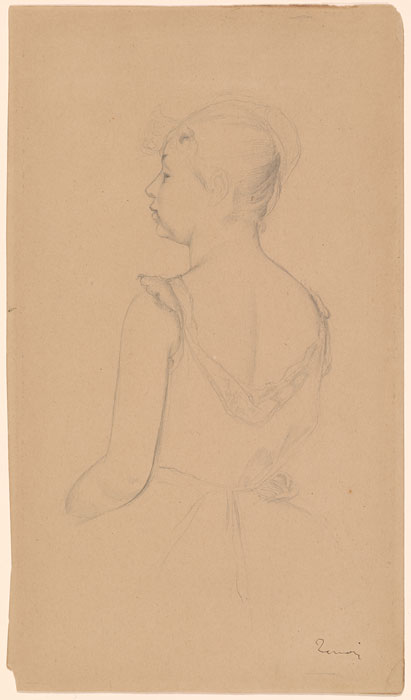
Renoir executed this study in preparation for one of his most well-known paintings, "Danse à la Ville," painted in 1883 with its pair, "Danse à la Campagne" (both now in the Musée d'Orsay, Paris). The model for the painting was Suzanne Valadon, and her lightly upturned nose, rounded cheek, full mouth, and up-swept hair are easily recognizable though here, unidealized. She wears a chemise which allows Renoir to focus on the curve of her shoulders and the line of her back, elements that become the focus of the painting.
"Danse à la Ville" is representative of a change in Renoir's technique in the early 1880s when his brushwork became more precise and his palette simplified. Renoir admitted that he was giving a keener attention to drawing at this time due to the need for change he felt after seeing Raphael's work during his travels in Italy in 1881. Later in life, Renoir wrote to the art dealer Ambroise Vollard: "I was going to tell you last time...about a sort of break that came in my work about 1883. I had wrung Impressionism dry and I finally came to the conclusions that I knew neither how to paint nor how to draw."
The subtlety of this drawing, with its delicately linear style, exemplifies this change and shows the precision and sensitivity of Renoir's use of the graphite pencil during this period, perhaps inspired by the drawings of Raphael and Renaissance metalpoint studies. This transformation in Renoir's style, which happened partly due to the lack of success his impressionist paintings received, was also clearly influenced by his profound study of Ingres. Indeed the years of the 1880s have been referred to as Renoir's 'Ingres period,' and this particular study appears to be his most Ingres-like showing a high degree of detail and observation in the face and expression and a great subtlety and range of shading.
The first owner of this drawing was the critic, thinker, and collector Roger Marx (1859-1913). A supporter of the new art of the avant-garde, Marx became a fervent champion of Gauguin. He built up an important collection of graphic art: Degas, Toulouse Lautrec, and Rodin were strongly represented in his collection. He defended the applied arts as a field worthy to be considered alongside the fine arts.
Marx, Roger, 1859-1913, former owner.
Guy-Patrice Michel Dauberville, "Renoir, Catalogue raisonné des tableaux, pastels, dessins et aquarelles," Paris, vol. II (1882-94), no. 1446.
